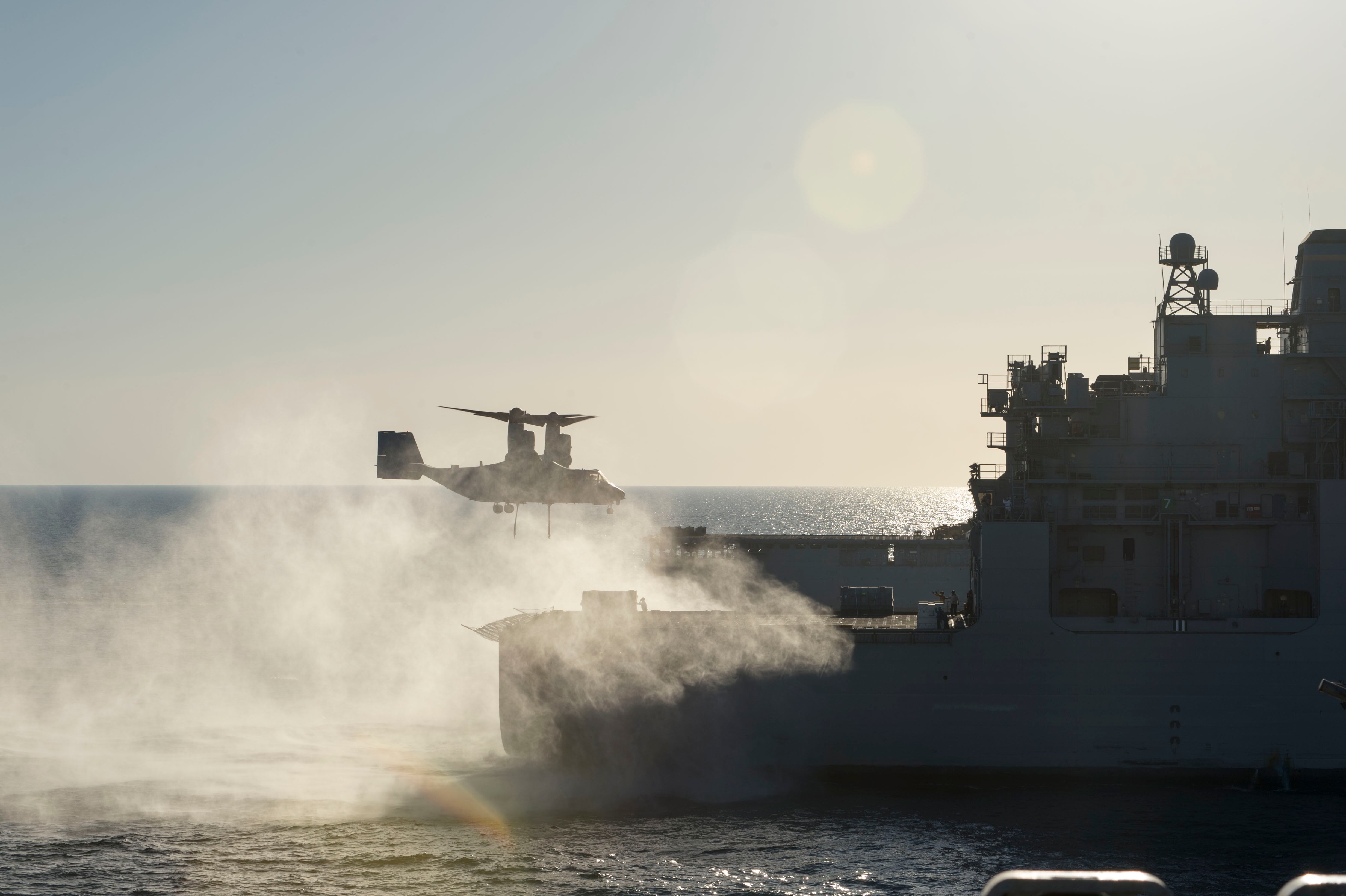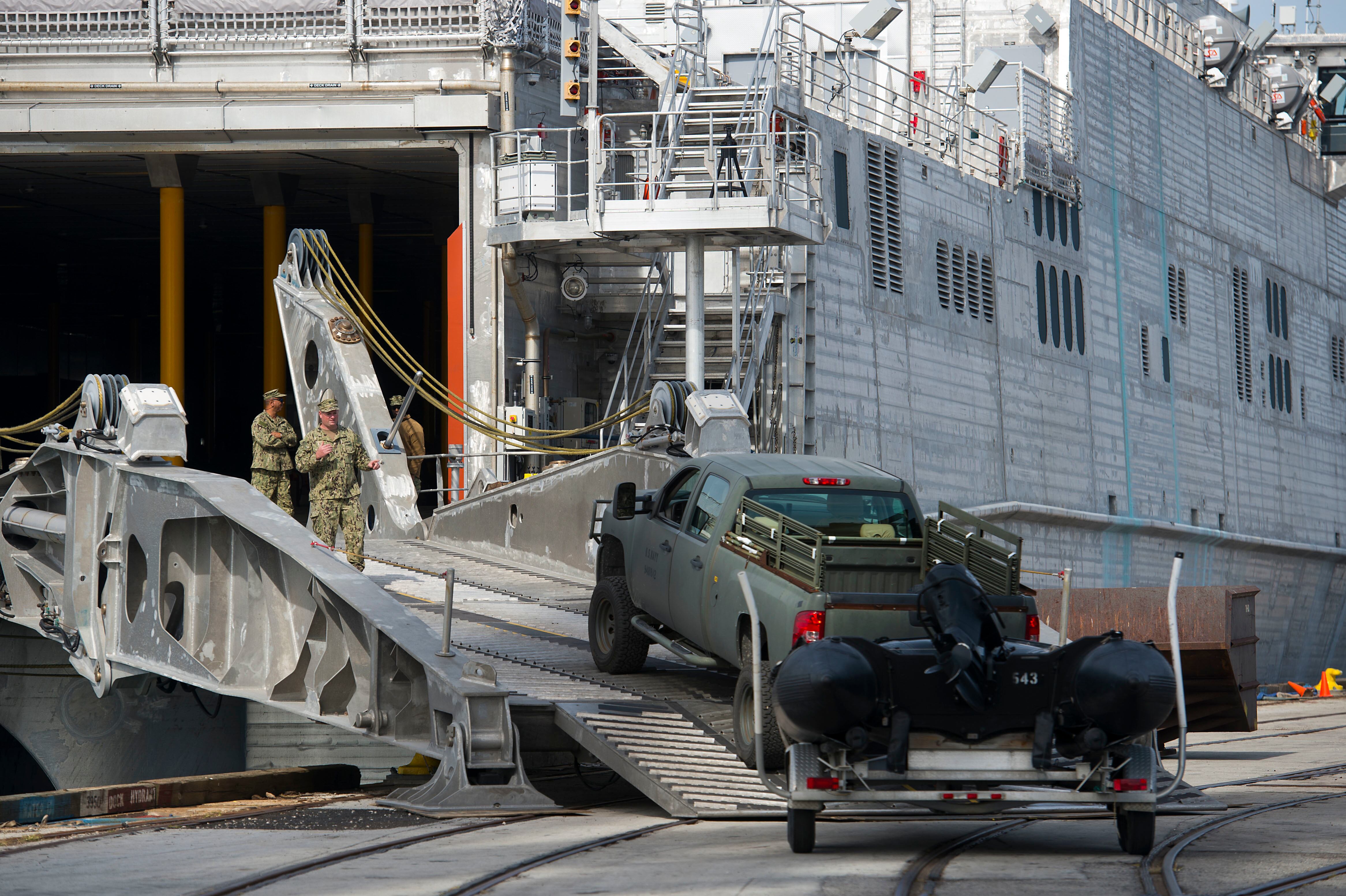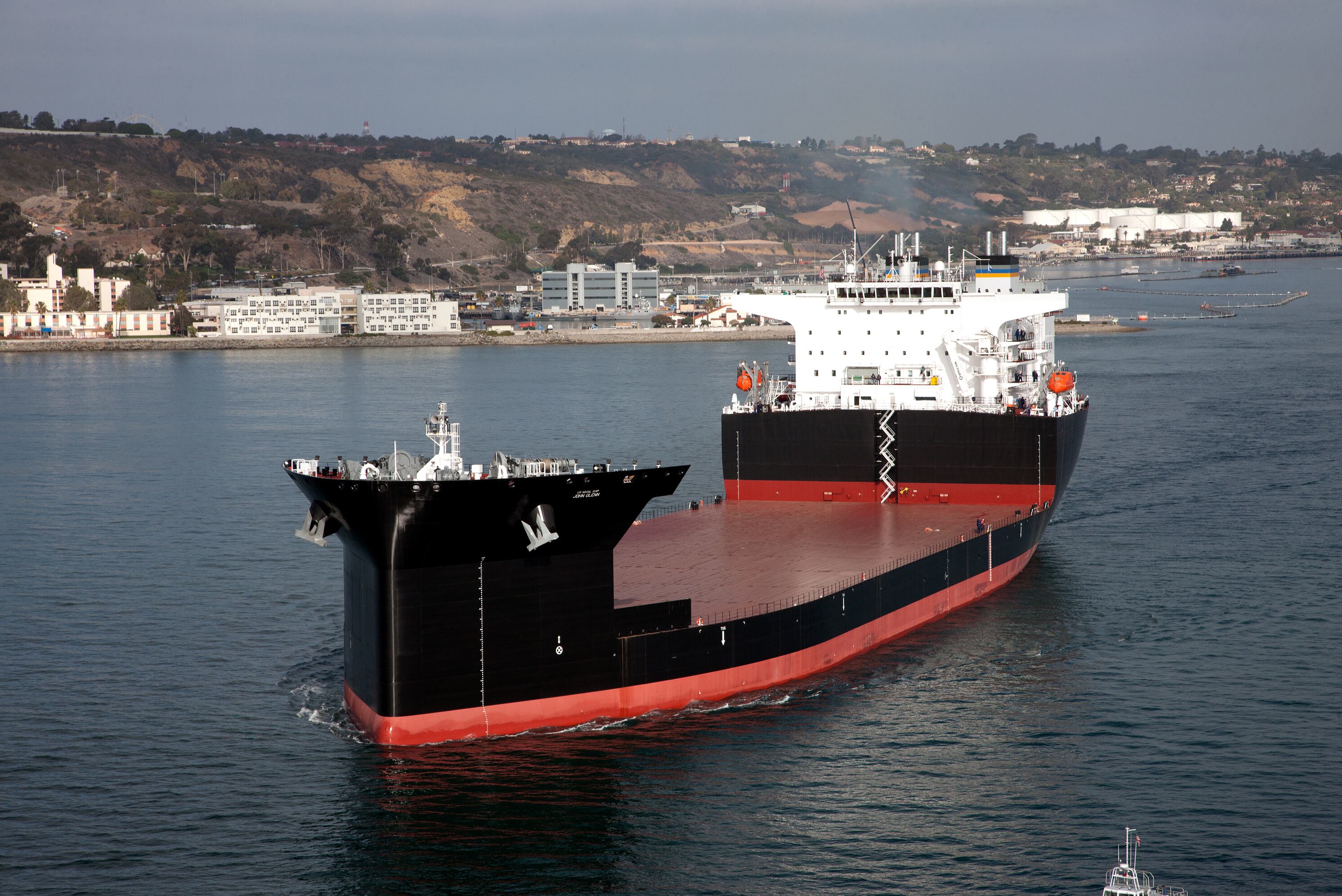Marines and sailors are at the center of a test that could change naval warfare.
Officials from the Corps and Navy are considering a new way of deploying Marines on a wide spectrum of vessels well beyond the standard pumps aboard amphibious assault ships. If the test runs are a success, aircraft carriers, destroyers, and even military cargo ships could become home to Marines headed to the world's next crisis.
Putting Marines on new ships could help military leaders and planners struggling with the shortage of amphibious assault ships. With fewer amphibs at sea, the Corps has stood up two land-based crisis response forces so Marines can be forward deployed to regions where contingencies could erupt. But being at sea is still ideal, according to service leaders, and putting Marines on new vessels could help meet growing mission requirements around the world.
The plan is in the early stages, and officials said it could give combatant commanders an additional company of Marines at the ready to recover a downed pilot, pull Americans out of an embassy under attack, or provide humanitarian assistance after a disaster. For Marines, it would mean new types of sea duty on ships across the Navy fleet.
In November, Marines tested the joint high speed vessel Choctaw County during Bold Alligator, the military's largest amphibious exercise. Members of Marine Corps Forces Special Operations Command operated from the catamaran for the first time, launching rigid inflatable boats from the JHSV.
This summer, Marines and sailors completed Adiutrix Spear, an experiment to determine what types of ships can embark Marines. During the evaluation, 22 Marines from Fleet Anti-terrorism Security Team Pacific went aboard the aircraft carrier George Washington, the destroyer Mustin, and the dry cargo ship Matthew Perry. FAST platoons are typically forward deployed to Spain, Bahrain or Japan to provide quick response to threats or disasters at government facilities worldwide.
Officials touted both exercises as successes, and are now looking to see what other types of ships, including forward staging bases and littoral combat ships, could be used to launch Marines on a variety of missions from the sea.
While the tests have so far been limited, Capt. Eric Flanagan, a Marine spokesman at the Pentagon, said Corps leaders are open to deploying Marines on more Navy platforms if it could provide combatant commanders with additional options.
Changing sea duty
Capt. Brandon Wheeler and his Marines were at the center of one of the new sea-based tests this summer. The commanding officer of FAST Company Pacific led a small team of Marines on missions launched from three different platforms. Adiutrix Spear demonstrated Marines' ability to stage, deploy, conduct medical evacuations and resupply from nontraditional ships like a destroyer, cargo ship and an aircraft carrier, he said.
"This exercise demonstrated that if we need to execute a mission in the future, we can build on a proven concept of employment from a variety of platforms," Wheeler said.

An MV-22B Osprey assigned to Marine Medium Tiltrotor Squadron 163 (Reinforced), approaches the Military Sealift Command dry cargo ship Robert E. Peary during a replenishment-at-sea. Marines with a Fleet Anti-terrorism Security Team took part in an experiment aboard a similar ship this summer.
Photo Credit: MC2 Christopher Lindahl/Navy
MV-22B Ospreys flew the Marines and their gear onto the cargo ship and carrier for staging. Once aboard and ready, they used MH-60 Seahawk helicopters to fly from the vessels to their missions where the Marines "eliminated a threat and performed expeditionary site security," Wheeler said.
On the carrier, they drilled with an explosive ordinance disposal team and worked with a helicopter squadron to test tactical insertion and resupply from a nontraditional platform. On the Mustin, they did sustainment training on the flight deck, Wheeler said.
During Bold Alligator, Rear. Adm. Larry Jackson, the deputy commander of the Military Sealift Command, said the dry cargo ships Lewis and Clark and the Sacagawea both "offered tremendous flexibility to the Marines," in preposition missions.
Adm. Bill Gortney, the former head of Fleet Forces Command, also praised the concept, and said the cheaper alternatives to amphibious ships makes good financial sense to augmenting the fleet for low-end missions.
If Marines become fixtures on ships of Military Sealift Command, carriers, and surface combatants, they'll have a type of sea duty that's different from the deployments they've had on amphibious ships. They wouldn't be in a Marine expeditionary unit embarked on gators alongside thousands of other Marines, but rather with sailors who aren't used to deploying with leathernecks.

A zodiac boat is towed onto the joint high speed vessel Choctaw County during Bold Alligator 2014. Marine deployments aboard nontraditional vessels like the JHSV could become more common amid a shortage of amphibious assault ships.
Photo Credit: Navy photo
Marines could also find themselves serving alongside civilians who have spent their careers crewing non-combatants. The Matthew Perry — the dry cargo ship Wheeler and his Marines were aboard — and other ships in the MSC are largely staffed by a cadre of non-military engineers, navigators and maintainers, with just a fraction, if any, of Navy personnel on board. These non-combatant vessels support warships with fuel, supplies and maintenance while underway.
Wheeler said life at sea on the different ships was good, but different than being on an amphib. Since Marines don't typically deploy on carriers and cargo ships, some accommodations had to be made.
On the carrier, they set up rubber mats and cots for their berthing. They ate with the sailors, and per the Navy tradition, officers and enlisted dined separately. The Mustin had smaller quarters, but the small crew was really tight-knit. It was clear that the sailors knew each other well and took war
fighting seriously, and it was easy for Marines to relate to them, Wheeler said.
"We could bond on that level," he said.
Life on the Perry, a civilian-crewed cargo ship, was unlike anything the Marines had experienced in the military. Wheeler didn't go onto the ship himself, but he said he saw pictures and heard reports from his Marines who were there.
"I will say that they were treated like kings on the Matthew Perry," he said.
There were private staterooms, plenty of space, a small civilian crews and the chow was excellent, he said.
Compared to combatants run by sailors, life on MSC vessels are luxurious. They have their own staterooms, top-notch menus, and recreation facilities not found on other naval vessels, said retired Navy Capt. Bob Sweeney, the former commander of Military Sealift Command, Far East.
"They [usually] get pretty fancy meals and places to eat and meals and lounges that are pretty unheard of in the Navy," he said.
While Wheeler's Marines got a taste of the good life, they might have just been lucky. Sweeney said that other MSC ships also have military personnel, and these mixed-crew vessels have different berthing arrangements, mess halls and recreation areas. The civilian crew lives in their relative luxury, while the military gets typical Navy chow and berthing.
"It was almost like a Carnival cruise," Sweeney joked. "There are sort of these passageways that say 'crew only' and they keep the passengers separated from the cruise ship crew."
Filling the amphib gap
Corps and Navy leaders are looking at putting Marines on the different ships for two reasons. First, the gator Navy, simply put, is spread thin from a heavy operational tempo. Second, they want to find ways to make the sea services more versatile, agile and flexible.
A report released by the Center for Strategic and International Studies this fall says Congress and the Defense and Navy departments are trying to fill the gap between the fleet's limited amphibious resources and the demand for their versatile capabilities. Ideally, the military would buy more amphibs, but budget restrictions make this unlikely. Due to fiscal limitations, officials are looking at other types of ships as an alternative, according to the study.
"One area of increasing focus has been how to more broadly leverage non-amphibious platforms," the report states. "This approach requires that we view these ships not just as transports or sea bases (in many cases), but as operational platforms."
This is a major issue for top brass. In March, Assistant Commandant Gen. John Paxton said that the amphib fleet can't keep up with demand, and they're looking for "alternative platforms" to supplement the fleet.

The Military Sealift Command mobile landing ship John Glenn shown off the California coast. Many ships in the MSC are staffed by civilians, and Marines could soon deploy alongside them.
Photo Credit: Navy photo
Former Marine Commandant Gen. James Amos and Chief of Naval Operations Adm. Jonathan Greenert also said that using alternative ships makes both services more flexible and provides a low-cost option for tackling problems as they emerge.
"We will evaluate and experiment with Marine detachments on ships other than amphibious vessels such as afloat forward staging bases, destroyers, littoral combat ships, mobile landing platforms, and joint high-speed vessels," they wrote in the June 2013 issue of the U.S. Naval Institute's June 2013 Proceeding Magazine.
That concept was also mentioned in Expeditionary Force 21, a long-term Marine Corps planning policy that emphasizes maritime missions and recalibrating the service after the wars in Iraq in Afghanistan.
It said the Corps needs to "modify traditional employment methods and augment amphibious warships by adapting other vessels for sea-based littoral operations." The plan said Pacific and Central Commands will get priority for amphibious ready groups and MEUs, but needs in other areas of operations might be handled by one amphib, or several amphibs joined by "alternative shipping."
Many details about how Marines would deploy aboard the new ships have yet to be determined. It's unclear what sort of impact putting Marines on more ships would have on deployment schedules or how the sea services would find room for Marines and their equipment aboard vessels where space is limited. Marines would also likely have to find new ways to maintain their skill sets while underway. And officials haven't determined if a Marines unit would be aboard a ship for its entire cruise, or meet up with it en route to an overseas hot spot.
For FAST companies, the size of the team aboard a ship will vary depending on the ship and mission. Wheeler and others said it could range from 18-member detachment to a company of 120 Marines. Larger teams will likely be spread across several ships, he added.
The CSIS study also warns that putting Marines on non-combatants come with a unique set of risks and limitations. MSC ships are less survivable than amphibious ships and they have poor defenses. They also have limited support, they don't have the same command and control capabilities, nor can they do intelligence, surveillance and reconnaissance.
Also, if Marines are on non-combatants, legal restrictions and treaties could limit the types of missions that they undertake, the study states.
Despite these shortfalls, the report said that non-amphibious ships can still help Marine missions, especially humanitarian relief efforts or bilateral training events. They might also be good options for chasing low-threat drug runners.
And following the recent experiments, Corps officials are trying to determine what Marines could do from other types of vessels, Wheeler said.
"Right now we have tested concepts from three vessels," he said. "We are expanding this concept and developing capabilities with additional platforms in the future."
So far, the admiral who saw Wheeler and FASTPAC in action had a glowing review of the concept, and said it could have a lot of potential in the Pacific.
"FASTPAC teams play an integral role in the 7th Fleet's ability to promote security and stability in the Indo-Asia-Pacific region," said 7th Fleet Commander Vice. Adm. Robert Thomas. "Training and deploying FASTPAC Marines aboard 7th Fleet ships is a huge force multiplier in the U.S. Navy's busiest area of operations."
Staff writer Lance M. Bacon contributed to this report.




